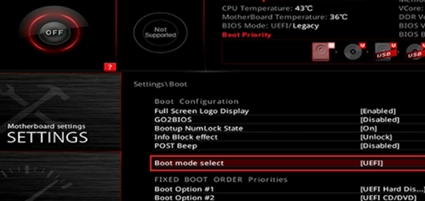Switching from BIOS (Legacy) Boot Mode to UEFI
This guide outlines how to transition a Windows computer from BIOS (Legacy) boot mode to UEFI with Secure Boot, ensuring you don’t have to reinstall the operating system or lose any data. Computers running in Legacy mode can only boot from disks using an MBR (Master Boot Record) partition table, so switching to UEFI requires converting the hard disk to GPT (GUID Partition Table) format.
Requirements for Conversion
Before you start the conversion process, ensure that your system meets the following prerequisites:
- Your motherboard supports UEFI boot mode, and Legacy BIOS mode is currently enabled.
- You are running an x64 version of Windows (Windows 10 version 1703 or later, or Windows Server 2016).
- Your device is not set up for dual-boot mode.
- BitLocker encryption is not enabled on the system partition.
- The system drive must be formatted with an MBR partition table and have no more than three partitions.
- You need sufficient free disk space to create an EFI system partition, typically around 100MB.
Open a PowerShell prompt to check if the system is booting in BIOS (Legacy) mode using the following command:
$env:firmware_typeNext, verify the partition style of the disk:
Get-DiskGet-Disk | Get-PartitionUsing MBR2GPT for the Conversion
Microsoft introduced the built-in mbr2gpt tool starting from Windows 10 version 1703, allowing conversion of a disk’s partition table from MBR to GPT without data loss.
First, validate if the MBR partition can be converted:
mbr2gpt /validate /allowfullosIf successful, you’ll see the message:
MBR2GPT: Validation completed successfullyIf you encounter a validation error, ensure that:
- The MBR drive does not have more than three primary partitions.
- It has no extended, logical, or dynamic partitions.
- At least 500MB is free on the disk is necessary to create system partitions and store the GUID partition tables.
If you see an error stating that it cannot find OS partition(s) for disk 0, you may need to enable the Windows Recovery Environment (WinRE):
reagentc /infoAfter ensuring all checks have passed, start the conversion:
MBR2GPT.EXE /convert /allowfullosOnce the command finishes, confirm the partition table conversion:
Get-DiskUpdating BIOS Settings
After successfully converting to GPT, restart the computer and enter the BIOS/UEFI settings. Disable Legacy BIOS mode and switch to UEFI+Secure Boot mode.
During boot-up, you can usually access the UEFI settings by pressing F2, Delete, or F1. Look for options that can refer to Legacy BIOS boot mode, such as Compatibility Support Mode, Legacy Mode, or CSM Boot, and change to UEFI.
If you are using a VMware virtual machine, adjust the VM settings to change the boot options to EFI firmware mode and enable Secure Boot.
Verifying UEFI and Secure Boot
Once Windows boots, check that UEFI and Secure Boot are functioning:
Confirm-SecureBootUEFIIf Secure Boot is disabled, verify that UEFI boot mode is being used with:
$env:firmware_typeNote for Older Computers
For older systems without UEFI support, Windows can still be booted from an external USB flash drive using an MBR layout, while a GPT partition table can be used on the system partition of the hard disk. For further details, consult the article on how to boot Windows from a GPT disk on a BIOS computer.
These steps will enable you to move from Legacy BIOS to UEFI mode without the need for reinstalling Windows or losing any data, paving the way for enhanced performance and security features.
